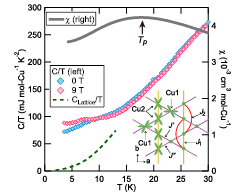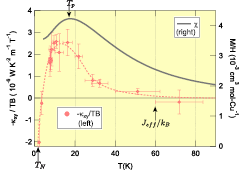Thermal-Hall effect in a Spin-Liquid State in Volborthite
M. Yamashita, T. Shibauchi, and Y. Matsuda
A central question in condensed-matter physics is a fate of electronic states under strong quantum fluctuations which often give rise to a variety of non-trivial quantum states. A prominent example is a quantum spin liquid (QSL) [1] of frustrated quantum antiferromagnets in which highly-correlated spins keep fluctuating down to very low temperature owing to enhanced quantum fluctuations. A few candidate materials now have been reported to host a QSL in two-dimension (2D), which have been attracting enormous attention because a 2D QSL is a new class of matter characterized by unknown quasiparticles. Identifying the precise nature of elementary excitations in a 2D QSL, however, has remained entirely elusive.

Fig. 1. Temperature dependence of the heat capacity divided by temperature C/T (diamonds, left axis) and the magnetic susceptibility χ (gray line, right axis) of a single crystal of volborthite. The peak temperature of the magnetic susceptibility is marked as Tp. The dashed line is the lattice heat capacity. The inset illustrates the arrangement of Cu ions in the ab plane. J1 and J2 represent the nearest-neighbor and next-nearest-neighbor interactions in the Cu2 spin chains, respectively. J' and J'' represent the nearest-neighbor interactions between Cu1 and Cu2 spins.

Fig. 2. Temperature dependence of –κxy/TB at 15 T (left) and that of χ (right). The dashed line is a guide to the eyes.
To shed a new light for studying unexplored property of the elementary excitations in a QSL, we utilize thermal Hall measurements to a spin liquid state realized in a 2D kagomé insulator volborthite Cu3V2O7(OH)2·2H2O. Volborthite is a magnetic insulator in which Cu2+ ions form a distorted kagomé structure with inequivalent exchange interactions [2] (see the inset of Fig. 1). The temperature dependence of the magnetic susceptibility χ is typical for frustrated spin system with the effective spin interaction energy Jeff/kB ~ 60 K; the peak of χ(T) at Tp ~ 18 K shows that a short-range spin correlation develops below Tp. Although the spin Hamiltonian is rather complicated [3], a geometrical frustration effect suppressed the magnetic order down to TN ~ 1 K, showing a presence of a spin liquid state in a wide temperature range TN < T < Jeff/kB. Extrapolating both χ and C/T above TN results a finite value at T = 0 (Fig. 1), demonstrating the presence of gapless excitations in the spin liquid state.
Our central finding [4] is a negative thermal Hall conductivity κxy (Fig. 2) which develops upon entering the spin liquid state (T < Jeff/kB) from the high-temperature paramagnetic state (T > Jeff/kB). Because volborthite is a transparent insulator without conducting electrons, a finite thermal Hall effect immediately means the presence of non-trivial excitations. At lower temperatures, |κxy| shows a peak at T ~ Tp, which is followed by a sharp decrease and a sign inversion just above TN. These intimate correlations between the temperature dependence of χ and that of κxy lead us to conclude that the observed thermal Hall effect in volborthite arises from the magnetic excitations in the spin liquid state, not from phonons. The emergence of the thermal Hall conductivity below T ~ Jeff/kB strongly suggests that the thermal Hall effect is a key signature distinguishing the highly-correlated spin liquid state from the conventional paramagnetic state. A further analysis [4] shows that an effective Lorentz force acting on the spin excitations can be estimated as ~1/100 of that for free electrons, implying that the coupling between the applied magnetic field and the spin excitations is very small.
The rapid decrease and the sign change of κxy near TN call further studies, especially about the spin correlation effect on the thermal Hall conductivity. Possibilities for the suppression of κxy would include an instability of a fictitious gauge field acting on the spin excitations and an emergence of an additional spin excitations with opposite sign of κxy. Applying thermal Hall measurements to another frustrated spin materials should be important to clarify these nontrivial issues.
References
- [1] L. Balents, Nature 464, 199 (2010).
- [2] H. Ishikawa et al., Phys. Rev. Lett. 114, 227202 (2015).
- [3] O. Janson et al., Phys. Rev. Lett. 117, 037206 (2016).
- [4] D. Watanabe et al., Proc. Natl. Acad. Sci. USA 113, 8653 (2016).
